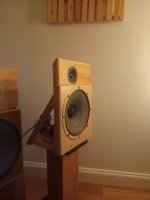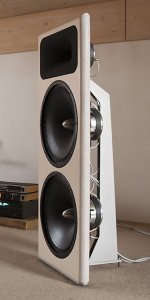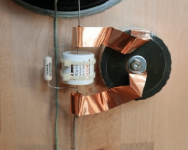Hi again!
And... oh, well.
I mean, well, well, well.
Or maybe I should say, well, well, well, well, well...
I mounted the TangBand W8-2145 - and it's a totally different animal.
For me, in this config, the difference is huge.
Everything is more defined, there is more space, it sound more natural, with crisper treble, gorgeous mids and (surprisingly) cleaner bass. Vocal is beautiful, the s-es are very natural. It's just a short summary, there is much more.
And the fine tuning of the xo follows as soon as have the parts...
All in all, great 😍

And... oh, well.
I mean, well, well, well.
Or maybe I should say, well, well, well, well, well...
I mounted the TangBand W8-2145 - and it's a totally different animal.
For me, in this config, the difference is huge.
Everything is more defined, there is more space, it sound more natural, with crisper treble, gorgeous mids and (surprisingly) cleaner bass. Vocal is beautiful, the s-es are very natural. It's just a short summary, there is much more.
And the fine tuning of the xo follows as soon as have the parts...
All in all, great 😍
very interested to see your final XO design - thanks for trying this driver in your experiments 

I mounted the TangBand W8-2145 - and it's a totally different animal.
For me, in this config, the difference is huge.
Everything is more defined, there is more space, it sound more natural, with crisper treble, gorgeous mids and (surprisingly) cleaner bass. Vocal is beautiful, the s-es are very natural. It's just a short summary, there is much more.
a comparison between this driver and the SB and the Mark Audio drivers would be appreciated. 🙂
3kTangBand W8-2145
Attachments
How much smoothing you apply?Hi,
today I made some measurements with the asymmetrical baffle in comparison with the centered driver, here the results:
Centered driver:
View attachment 1204423
Asymmetrical baffle:
View attachment 1204424
The asymmetrical baffle seems to have a more even frequency response between 500 Hz and 2 kHz, but above this range it begins to make waves and here the centered driver works better.
Stan made a sim for the off-center driver, I made another one with slightly different parameters, the difference in driver position is 1 cm, so not really relevant - but the centered driver shows a better frequency response. And - it sounds better, especially in the middle range more lively. Where is the error, if there is one at all? It's "always said" that a centered FR is actually a no go, although Pa's SLOB and many other designs are also built that way. Should I stop worrying about this? - and listen to my ears. Here is the picture of the asymmetrical baffle (just a trial version):
View attachment 1204430
Hi,
although the TangBand are still in the burn in phase, I would like to make a first comparison of this driver with the Alpair 12P and the SB.
Bass... oh, yes, I know the bass range isn't really the one that should be compared in this configuration, but: with the TangBand the bass range is simply cleaner and less discolored than with the other two.
Midrange: The TangBand is incredibly open, detailed, free of distortion and presents vocals beautifully. It always remains calm in the sense of being stable, very well proportioned, not superficial and completely without sharpness (to which I react extremely).
The SB, on the other hand, is a little impetuous, sometimes shrill, sometimes distorted and not as detailed. The Alpair is far too quiet for me in this area, sometimes a bit boring, and lacks the captivating gameplay that the other two have.
Treble: The TangBand has a very clear and detailed presentation and for me stands out over the other two. This driver also knows how to arrange the instruments spatially in this area too. The SB also plays nicely in this area, but the last bit of finesse, undistortedness and clarity is missing. For me, the Alpair is clearly behind the two. If you listen to this driver directly after the SB, it seems like a revelation at first, because the SB - as already mentioned - plays impetuously, while the Alpair remains calm, but this calmness soon creates boredom.
General: The TangBand also wins when it comes to stage imaging, an incredible stage is presented, the space is phenomenal. In addition, the sound is the most credible with this driver. Very dynamic without appearing strained or strenuous, it never becomes intrusive. A huge plus is the ability to display even complex music brilliantly. As far as audibility is concerned, the Alpair is ahead of the SB here, but as I said, this is caused by the somewhat more boring style of playing. To my ears, the SB is not fully suitable for complex music; the music quickly seems confusing.
Conclusion: The TangBand is a really great driver and way ahead of the SB, the Alpair is third.
Note: This review is of course subjective, and only reflects my opinion when using this driver with my xo in my baffle in my listening environment. Others might, of course, come to a different conclusion.
although the TangBand are still in the burn in phase, I would like to make a first comparison of this driver with the Alpair 12P and the SB.
Bass... oh, yes, I know the bass range isn't really the one that should be compared in this configuration, but: with the TangBand the bass range is simply cleaner and less discolored than with the other two.
Midrange: The TangBand is incredibly open, detailed, free of distortion and presents vocals beautifully. It always remains calm in the sense of being stable, very well proportioned, not superficial and completely without sharpness (to which I react extremely).
The SB, on the other hand, is a little impetuous, sometimes shrill, sometimes distorted and not as detailed. The Alpair is far too quiet for me in this area, sometimes a bit boring, and lacks the captivating gameplay that the other two have.
Treble: The TangBand has a very clear and detailed presentation and for me stands out over the other two. This driver also knows how to arrange the instruments spatially in this area too. The SB also plays nicely in this area, but the last bit of finesse, undistortedness and clarity is missing. For me, the Alpair is clearly behind the two. If you listen to this driver directly after the SB, it seems like a revelation at first, because the SB - as already mentioned - plays impetuously, while the Alpair remains calm, but this calmness soon creates boredom.
General: The TangBand also wins when it comes to stage imaging, an incredible stage is presented, the space is phenomenal. In addition, the sound is the most credible with this driver. Very dynamic without appearing strained or strenuous, it never becomes intrusive. A huge plus is the ability to display even complex music brilliantly. As far as audibility is concerned, the Alpair is ahead of the SB here, but as I said, this is caused by the somewhat more boring style of playing. To my ears, the SB is not fully suitable for complex music; the music quickly seems confusing.
Conclusion: The TangBand is a really great driver and way ahead of the SB, the Alpair is third.
Note: This review is of course subjective, and only reflects my opinion when using this driver with my xo in my baffle in my listening environment. Others might, of course, come to a different conclusion.
Which Alpair? Also when comparing it, while it‘s ”dynamic” capabilities are lacking, how about soundstage width and depth when compared to the Tangband along with detail?
This one looks interesting for an open-baffle mid-high:
https://www.lii-audio.com/product/o...kers-ideal-desktop-and-bookshelf-unit-fast-6/
-needs correction at 3.4 kHz based on graph.
https://www.lii-audio.com/product/o...kers-ideal-desktop-and-bookshelf-unit-fast-6/
-needs correction at 3.4 kHz based on graph.
-a small Chinese manufacturer, I’m sure the driver is cherry-picked and only slightly represents average results.
Really the driver is more interesting as an open-baffle midrange, with a low-pass below the transition point to the whizzer’s pass-band.
Really the driver is more interesting as an open-baffle midrange, with a low-pass below the transition point to the whizzer’s pass-band.
Which Alpair?
😉...with the Alpair 12P...
For me, the TangBand has a beautifully organized stage with great depth, width and height and the instruments are placed great within it. Subtleties like echoes and everything else that has to do with spatiality are presented much better.
In comparison, the A12P is a little smaller everywhere.
And here too: that's just my opinion, others may see or hear the whole thing differently.
- Home
- Loudspeakers
- Multi-Way
- My open baffle journey



